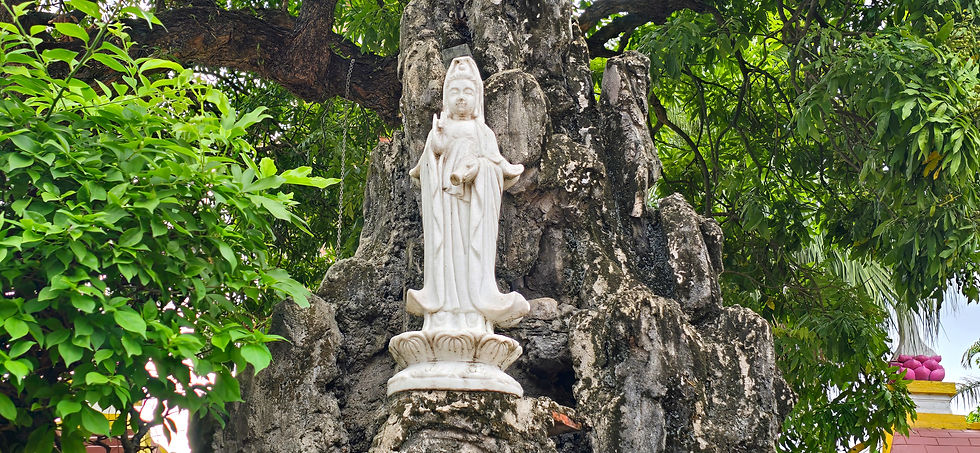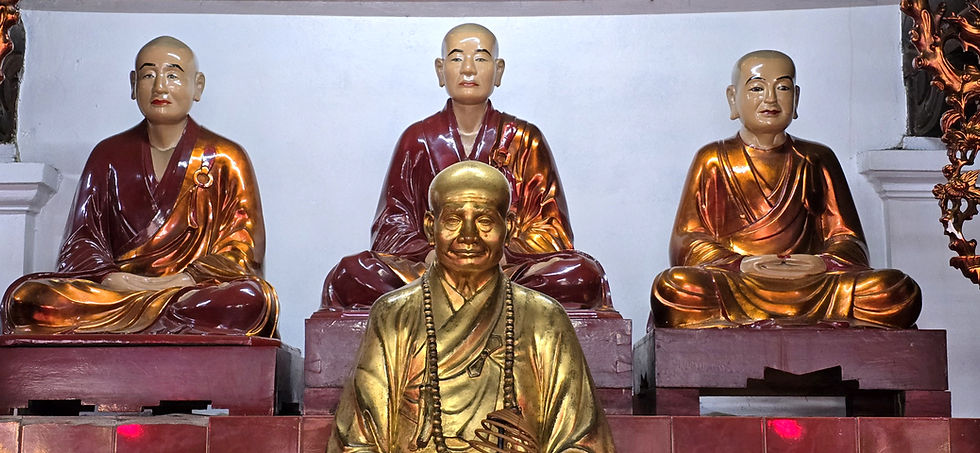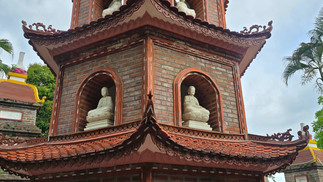The Legacy of Trấn Quốc Pagoda
- Shannon
- Jun 23
- 3 min read
With its origins stretching back over 1500 years, Trấn Quốc Pagoda holds the distinction of being the oldest Buddhist temple in the country. It was originally built around 545 AD during the reign of Emperor Lý Nam Đế, who commissioned its construction as part of a broader vision to legitimise Vietnamese sovereignty in the midst of political upheaval and resistance against Chinese rule. The temple was first named Khai Quốc, meaning “Founding of the Nation" and was initially located on the banks of the Red River near the ancient village called Yên Hòa, where it stood as a spiritual anchor for a newly independent kingdom.

In the 17th century, Trấn Quốc Pagoda was relocated from where it had stood for over a millennia, to a small islet near the south-eastern shore of Hanoi’s West Lake. The move was prompted by severe riverbank erosion that threatened the temple’s stability. Under the reign of King Lê Kinh Tông, the ancient monument was carefully dismantled and reassembled at its new location, with sacred artefacts and architectural elements preserved. The new site offered a more stable foundation and a peaceful lakeside setting, enhancing its spiritual significance. After the move, the pagoda continued its legacy under the name Trấn Quốc, meaning "Protecting the Nation".
The architecture of Trấn Quốc blends sacred symmetry with nature. At its heart stands an 11-storey red brick stupa, completed in 2004, reaching nearly 15 meters tall, with each level housing a jade Buddha statue. At the top, a nine-story lotus symbolises enlightenment. Ancient bodhi trees, including one gifted by India’s President Rajendra Prasad in 1959, surround the stupa and are believed to be descendants of the tree under which the Buddha attained enlightenment. The main temple hall, adorned in rich red and gold, features intricately carved altars, stone steles and statues of Amitabha Buddha and Avalokiteshvara.

Dark Vietnamese folklores speak of spirits drawn to West Lake's waters. The area surrounding the pagoda was once believed to be haunted by the ghosts of drowned maidens, sacrificed in pre-Buddhist rituals to appease water deities during times of drought. Local lore claims that on certain misty nights, spectral figures in white are seen drifting near the pagoda’s reflection, neither fully in this world nor the next. These ghostly figures are not malevolent but instead evoke sadness and a sense of mourning for their lives that were stolen.


Though it is one of Vietnam’s most visited religious sites, Trấn Quốc Pagoda remains a living monastery, home to a small number of resident monks. These monastics uphold daily rituals, care for the temple grounds and guide visitors in Buddhist practice. In accordance with Vietnamese Buddhist tradition, the ashes of respected monks are often interred in stone burial stupas. Several memorials, along with the relics and ancestral tablets, can be still be found scattered around the complex, honouring the lives and teachings of the monastics who dedicated themselves to the Dharma.

Alongside the central worship of Buddhas and Bodhisattvas, there are altars dedicated to the Mẫu or Mother Goddesses. These revered deities embody the forces of nature, with each Mẫu overseeing a distinct realm: Heaven (Mẫu Thượng Thiên), Water (Mẫu Thoải), Mountains (Mẫu Thượng Ngàn), and Earth (Mẫu Địa). Their inclusion at this sacred site reflects the Vietnamese people's unique spiritual syncretism, where ancestral reverence, nature worship and formal Buddhist practice are seamlessly interwoven.


Location : 190 Quán Thánh Street, Quán Thánh, Ba Đình, Hà Nội
How to get there : Quán Thánh Temple is situated in Hà Nội's Ba Đình District, approximately 3km's northwest of the Old Quarter, close to the Presedential Palace and Ho Chi Minh Mausoleum. Walking from the Old Quarter will take about half an hour and offers an opportunity to explore the city en route. Alternatively, visitors can reach the pagoda within 15 minutes with a Grab taxi or motorbike.
Attraction Info : Admission is free for all visitors. The temple is open daily between 8am - 11:30am and 1:30pm - 4pm, however on the 1st and 15th of each lunar month, the temple extends its hours from 6am - 6pm. Visitors are expected to dress modestly, ensuring shoulders and knees are covered, to show respect for the sacred site. Overpriced sarongs are available to purchase outside the gate, if you forget to bring your own.
Thanks for reading The Legacy of Trấn Quốc Pagoda. Check out more destinations here!

The ashes of monks long passed are interred inside the smaller brick pagodas






















